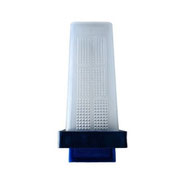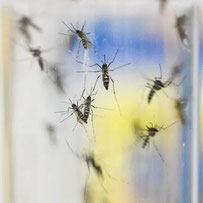Release Cages For Insect Research & Control
Insect Release and Transport Cages

Insect Release Cages. Management strategies involving the mass-release of living control agents have been developed, including genetic control with insects and biological control with parasitoids. The final step of control programs is often the release of insects in the field. Different release cages (also "insect release boxes") for ground-based release of mosquitos, rigid or collapsible, single or modular, were developed by Vienna Scientific for research partners to allow for releasing highly defined quantities (of mosquitos) and preventing injuries during the storage and transport prior to release - both significantly enhancing the effectivity of the insect pest or vector management measures. Contact us to develop and build insect release cages fitting your species, entomology research needs and insect pest control programs! Some designs of mosquito release cages are shown below for illustration purposes.
Insect Release Cages - Features
Meeting the application / species, release cages are fully customized to user specifications.
- various materials available (nets, perforated plastic etc.)
- rigid or collapsible
- creped bottom for water/feeding solution
Optional:
- Automatic release mechanism
Application Potential of Insect Release Cages

Insect release cages are enclosures designed to contain, transport and release defined numbers of insects in a controlled manner. They are commonly used in insect ecology, pest management and biological control programs such as SIT. Insect release cages are typically made of mesh or netting material, but also perforated plastic - allowing air and light to pass through while preventing insects from escaping. Cages can be of various shapes and sizes depending on the number and size of insects to be released, filling procedures, transport conditions, and the desired release rate / process (manual, automated, ground or airborne). Insect are usually entered to cages in the rearing facility in a chilled, immobilized state. Potentially, insect aspirators / collectors with fans (for creating a suction force) could be used to aspire insects to release cages. Some cages may also have a central release point or door that allows insects to be released in a specific location or direction, or to be automatically deployed using UAVs. Cages for mass release programs are ideally collapsible after use and modular, reducing transportation volume and costs, Release cages ideally also include bottom plates of creped paper, sponges or similar to provide the insects with moisture or sugar solution during transport and/or acclimation phases.
- Insect release cages are used for a variety of purposes, including ... Continue reading
-
- Study of insect behaviour and ecology: Insect release cages can be used to study the behaviour or reproduction of a limited number of insects in a controlled environment. This can provide valuable information for understanding (small) insect populations / individuals and developing management strategies making insects easier observable then in large or medium-sized insect colony cages.
- Pest and disease management: Insect release cages can be used to release sterile or genetically modified insects as part of pest and disease control programmes. The released insects mate with wild populations, reducing the number of viable offspring and eventually suppressing the pest population. Forthermore, relased insects do not carry potential vectors (malaria, dengue etc.).
- Biological control: Insect release cages can be used to release natural enemies, such as parasitoids or predators, to control pest populations. The rate and timing of release, as wel as the location can be carefully controlled to maximise the effectiveness of the biological control agent.
- Conservation: Release cages can be used to reintroduce ex situ bred, endangered or rare insect species into their natural habitats. The cages provide a protected environment for the released insects, allowing them to acclimatise before being released in the wild at specific locations.
Overall, insect release cages are a particularly important tool for the control and management of insect populations. However, cage design need to be adapted, developing optimal solutions for specific species and tasks. Vienna Scientific supports you in developing effective release cages for your insect research and/or management application - get in contact!
| References | Insect Release Cages | OPEN |
|
||
INSECT COLONY CAGES
For large or medium-sized insect cages for rearing and oviposition harvesting, consider our custom insect colony cages for mosquitoes and other insects.








